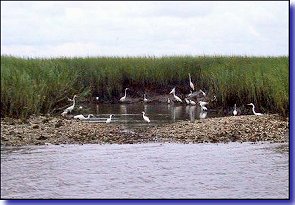Egrets
|
Marsh Critters: Egrets |
|
|
|
Classification
|
| Common Egret, American Egret | |||||
Distinguished from the snowy egret by its greater size (wingspan can be over 50 inches), its yellow bill, and black legs and feet, the great egret can be spotted along the river and creek banks in a marsh.
While great egrets spend the winter from South Carolina southward, they can be found as far north as Massachusetts in the summer. Their nests, made up of reeds and sticks, are often high up in trees and may harbor as many as five or six eggs. In the breeding season, both males and females exhibit long back plumes that were once valued in the feather trade.
Egrets are excellent fishermen who stand motionless in the water waiting for fish, although snakes, frogs, or some insects may be added to their diet. They eyes are specially equipped with a lens which compensates for the refraction of light in the water.
|
|
Classification | ||
|
Kingdom Phylum Class Order Family Genius Species |
Animalia Chordata Aves Ciconiiformes Ardeidae Ardea Egretta thula |
 American Egrets and Snowy Egrets
American Egrets and Snowy Egrets
| |
| Snowy Egret | |||
The bird with "the golden slippers". Seen in marshes, ponds, and mud flats, it stands only 20-27" tall. It usually holds its neck in an "S" curve in flight and has entirely white plumage. It has black legs and yellow feet. It likes to feed on fish, shrimp, frogs, crab, reptiles and insects. It nests in trees.